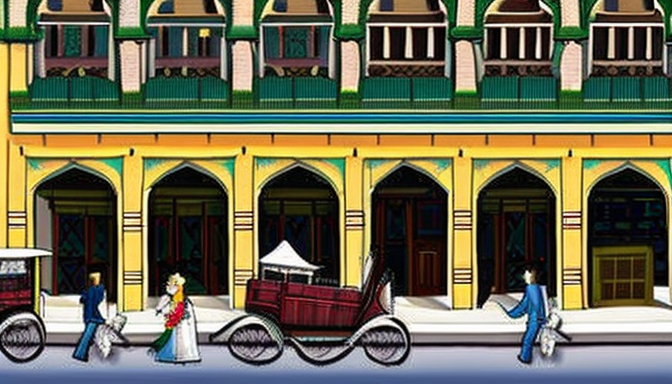Karachi, a bustling metropolis, is a city where the past and present collide. The influence of British architecture is palpable, echoing through its streets and buildings. Have you ever walked past a grand colonial structure and felt a sense of history? That’s the charm of Karachi’s architectural landscape, shaped significantly during the British colonial era. From the late 19th century to the mid-20th century, British policies and architectural styles transformed Karachi into a city that mirrors both tradition and modernity.
During British rule, Karachi saw the rise of magnificent buildings that were not just functional but also symbols of power and prestige. Think about the iconic Frere Hall or the majestic Karachi Port Trust Building. These structures were designed with a blend of European aesthetics and local materials, creating a unique architectural identity. This fusion didn’t just happen by chance; it was a reflection of the socio-political climate of the time. The British wanted to establish their dominance while also adapting to the local environment.
Today, the legacy of British architecture continues to influence modern Karachi. Contemporary architects are not just preserving these historical gems; they are also integrating British styles with local designs. This blend creates a vibrant urban landscape that respects its roots while addressing the needs of a growing city. It’s like a dance between the old and the new, where each step tells a story. Karachi’s architectural evolution is a testament to its rich history and dynamic future.
The Colonial Legacy
Karachi’s architectural story is deeply intertwined with its colonial past. When the British arrived, they didn’t just bring their governance; they brought their architectural styles too. Imagine walking through the city and seeing buildings that echo the grandeur of London. These structures were more than just walls; they were symbols of power, control, and a new way of life. The British architects introduced neoclassical and Gothic styles, which can still be seen in some of Karachi’s most iconic buildings.
Take the Frere Hall, for instance. Built in 1865, it stands as a testament to the British penchant for grand designs. Its arches and columns tell a story of a time when Karachi was a bustling port city under British rule. But it’s not just about aesthetics. These buildings were part of a larger plan. The British aimed to shape Karachi into a modern city that reflected their values and governance.
The policies of the time also played a crucial role. The introduction of zoning laws and urban planning transformed Karachi into a structured city. This wasn’t just about creating beautiful buildings; it was about establishing a framework for a growing metropolis. The legacy of these policies is still evident today, as Karachi continues to grapple with urban challenges.
In summary, British-era architecture in Karachi is not just a relic of the past. It’s a living part of the city’s identity. Every brick tells a story, and every corner reflects the complex history that shaped modern Karachi.

Modern Adaptations
Karachi is a city that wears its history proudly. The influence of British architecture is not just a relic of the past; it continues to shape the skyline today. Modern architects in Karachi are taking cues from these colonial designs, creating a unique blend of the old and the new. Imagine walking through a bustling street where Victorian facades meet contemporary glass structures. It’s like seeing a beautiful dance between the past and the present.
Many buildings today incorporate elements from British architecture. Think about arched windows, ornate balconies, and spacious verandas. These features not only add charm but also serve practical purposes. For instance, high ceilings help keep buildings cool in the sweltering heat. Architects are not just copying; they are adapting. They respect the historical significance while addressing the needs of a growing urban population.
Take a look at some recent projects:
| Building Name | Architectural Style | Year Completed |
|---|---|---|
| Frere Hall | Gothic Revival | 1865 |
| Karachi Port Trust Building | Neoclassical | 1916 |
| New MCB Tower | Contemporary | 2016 |
These adaptations show how Karachi is not stuck in time. It’s a city that evolves, embracing its rich history while looking forward. It’s like a tapestry woven from threads of the past and present, each telling a story. So, the next time you stroll through Karachi, take a moment to appreciate this architectural dialogue. It’s not just buildings; it’s a reflection of a city that honors its roots while stepping boldly into the future.
Frequently Asked Questions
- What is the significance of British architecture in Karachi?
British architecture has played a crucial role in shaping Karachi’s identity. It introduced unique styles and structures that reflect the city’s colonial past, influencing its urban landscape even today.
- Are there any notable buildings in Karachi that showcase British architectural styles?
Absolutely! Iconic structures like the Frere Hall and the Sindh Assembly building are prime examples. These buildings not only highlight British architectural elements but also serve as historical landmarks that tell the story of Karachi’s evolution.
- How are modern architects in Karachi blending old and new styles?
Modern architects are creatively merging British influences with local designs, resulting in a vibrant architectural scene. This fusion respects traditional aesthetics while addressing contemporary needs, creating a unique urban experience.
- What challenges do architects face when incorporating historical styles?
One major challenge is balancing preservation with innovation. Architects must respect the historical significance of these structures while ensuring they meet modern safety and functionality standards.